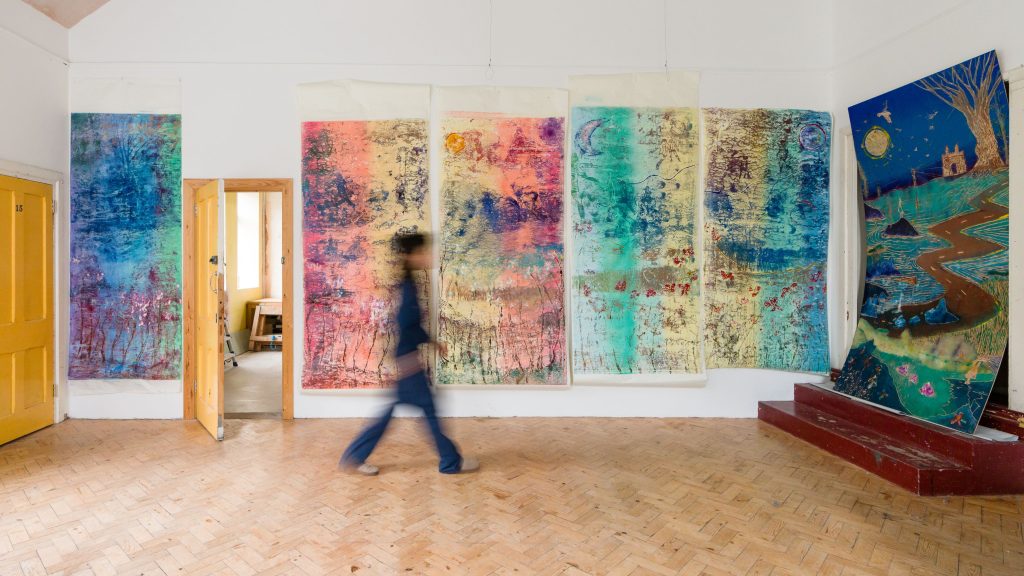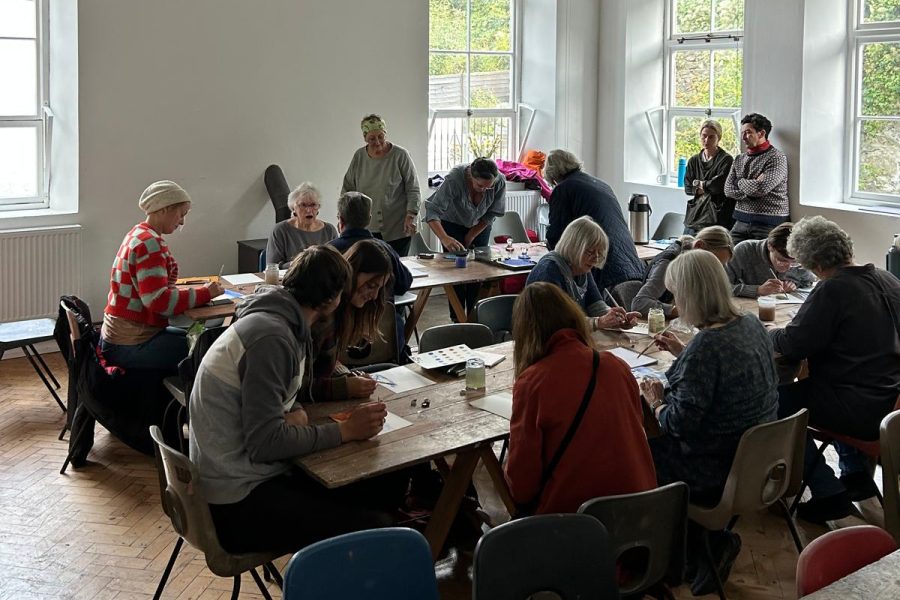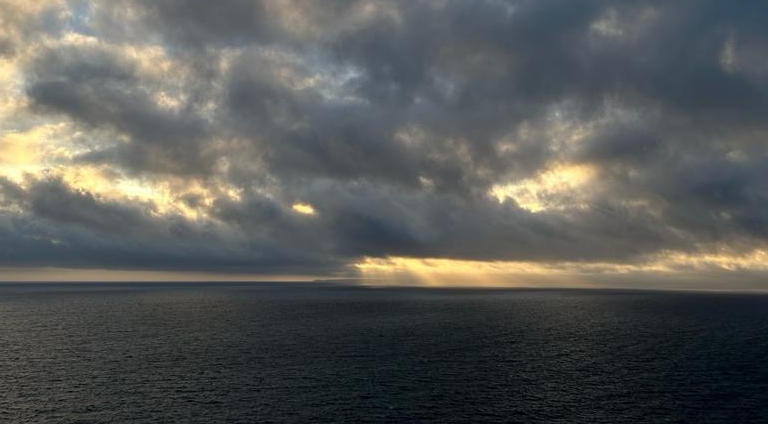At the start of the year, CAST welcomed artist Yael Roberts for a one-month residency in Studio 15. She has since written the following report, reflecting on her experiences during her time in Cornwall.
In January-February 2024 I spent a month in residency in Studio 15 at CAST. The residency was funded by a DYCP grant from Arts Council England, which also afforded me a month in Mexico in 2023. I wanted to dive deeper into the roots of my practice. Knowing how connected I felt to Cornwall (I was also artist-in-residence at Fish Factory Arts in Penryn back in 2021 and have been returning regularly to Cornwall ever since), I was curious what treasures this special place held for me this time around. My time at CAST felt a bit like coming home, to a place I had met a few times before and could steadily get to know again. The month felt like a kind of dream, dreaming in the studio, dreaming the work, being in and of the work in a symbiotic way I hadn’t experienced before. I try to recount that dream here, in images and words.
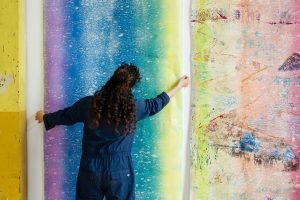
The Friday I arrived in Helston was a rare sunny day, the town spread out beneath me as I hauled the small electric bike I had borrowed from my housemate up Penrose Road, laden with printmaking inks I hadn’t been able to ship via Parcelforce. A host of materials that I had managed to send in advance awaited me and I was eager to get stuck in. I’d spent weeks preparing for the residency: measuring, planning, making lists, and bracing myself for this month of solitude. I sat in the high-ceilinged CAST Café, looking out into the distance and the Helston churchyard complete with a striking pine tree that seemed to haunt my time in the town. It watched over me from a distance, sometimes moving slightly in the wind, but mostly unwavering. I finished my coffee and went upstairs to unpack.
Although eager to begin, I also knew that a large part of my process would be exploring the local area. My work is often inspired by the places I travel to, so the electric bike was a godsend, meaning that regular trips to Porthleven Beach and Gunwalloe Church Cove were possible. I would begin work as early as I could, then often rush out for a swim before the winter sun set.
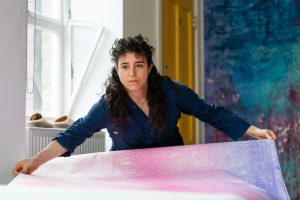
How the sea would greet me was always a surprise. My swim at Trebah Gardens was quiet and uneventful. The sun was out, the water calm. But back near Helston, the sea was raging. The Loe Bar, a place too dangerous to swim, loomed nearby. It didn’t help that I often made it out to swim at sunset, which was high tide most of the time. At dusk on Rinsey Cove, the waves crashed in such earnestness I wondered what they were trying to say. At Porthleven, I’d enter the water and quickly be pummelled over by the waves. But I could retreat into the hills of Helston, with the sea far enough away, finding space in the trees and rows of houses for a more surreal and calm existence.
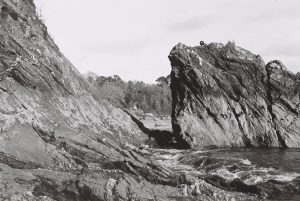
I loved exploring the stones on the beaches, the ‘zawn’ (“vertical fissure or cave cut by wave action into a coast cliff”*) caverns at Porthleven and Gunwalloe, and the black sparkling rocks jutting out of the sea at the Lizard. These stones felt like a way of marking home, little solid moments I could carry. I was dreaming of the stones of Audre Lorde’s Parting, in which she writes, ‘I talk to rocks / sometimes they answer / double-voiced / as a woman in love / taking leave / in roars of jade.’
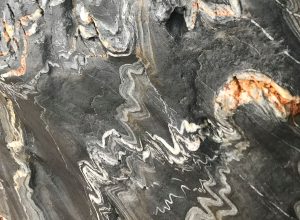
Because of the way I work, in cycles of preparation, printing, and then letting the work dry, I was also able to take full days off from the studio, to explore the local landscape. One way that felt pertinent to do this was through women’s football. I had been attending matches in London (having not been able to play since April due to an injury) and on my first Sunday, soaking wet already from the short cycle, I arrived at the RNAS Culdrose community pitch. Entering the clubhouse, the walls lined with trophies, I purchased a pack of peanuts and crouched by the side of the pitch with my analogue camera, surprising parents and players alike. I knew these photos would be a starting point, and I treated this as research, an important way to understand the female body, landscape, and the rifts within. Everyone stood around in dry robes, and the girls chased after the football as if it were a prize, as the wind blew anything it could away.
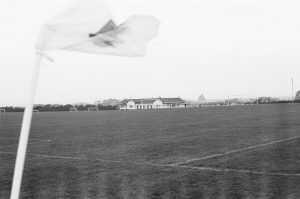
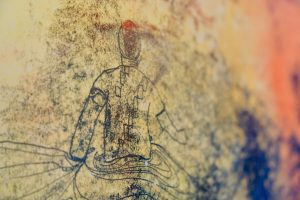
Another field trip highlight was visiting the old Ponsharden Cemetery. Here, the friends of the cemetery have restored the vandalised headstones. The ‘dissenters’ burial ground and adjacent Jewish cemetery fell into disuse and a state of great neglect, becoming, for a time, simply an unkept shortcut from the main road to the supermarket. Both have now been impeccably restored, with broken headstones repaired and standing proud on the hillside like rock formations sticking out of the sea at low tide. However, they are not yet open to the public and I was shown around by Anthony Fagin, a retired ceramicist and custodian of the cemetery, who I’d been in touch with years before about a visit, when I first planned my DYCP project. Anthony spoke lovingly about each headstone and how it had been restored. The stones were carved into, like woodblocks; they reminded me of my work and the allusions to texts and scrolls in its carvings.
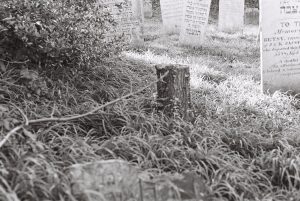
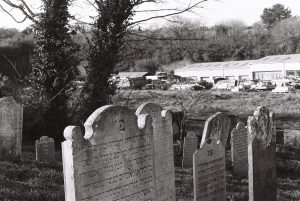
The two aims I had set myself for this period of funding, intended to help me develop my creative practice, were to work with more photographic imagery in my printmaking, and to incorporate clay into my work. Since my residency at Casa Ceniza in Mexico, I have become fascinated with local earth, with clay as a marker of place and another kind of ‘found object’. CAST has its own independently run ceramic studio – Clay Trap – and one of the joys of my residency was leaving the studio and going downstairs for open access sessions in the evenings. Sarah Fassnidge, who co-runs the studio, showed me amazing foraged clay from the Lizard, and when I ventured down to the Lizard to walk, I could feel this soft earth under my feet that I had touched days earlier. When I arrived at CAST, Yusof Abdul-Rahman’s film on China Clay was screening. Having watched it, I ventured out to explore the China Clay landscape myself. This derelict landscape was foggy and surreal, with reds, yellows, greens and turquoise punctuating the whiteness. It made me think about the marks we humans leave on a place, and the way that place leaves marks on us.
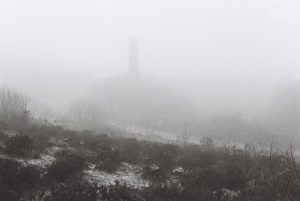
After long days of exploring and making, at night I would often build a fire and read and sketch by the hearth. I had not expected to be warm; my studio at Cubitt in London had been freezing when I left. The possibility of making work in a warm space was shocking and beautiful. When the fire would die down, I would crawl onto the sofa bed, more comfortable than I had anticipated, and lie awake looking at the work by the glow of the lamp. At a residency back in 2017 at Oficina Bartolomeu dos Santos in Tavira, Portugal, I had slept upstairs from the print room. But never before had I slept in my studio (not even for an occasional night) and this felt like a precious and daunting opportunity.
The studio in the middle of the night was a strange beast, the old school empty except for the wind (I arrived during Storm Isha) and the sound of my footsteps, while outside I could hear loose branches and stacked furniture rattling in the wind. The odd light would twinkle on and off, and Clay Trap members worked late. But by 2am I was alone. Without much exercise (I was so bound to the studio and its mysteries) I found myself often lying awake at night pondering the work in the dark, listening to the sound of the empty studio. With very little streetlight or moonlight entering the studio, the work became monstrous by night, a new creature in the dim light. Restless, I avoided venturing far beyond my studio area. Even though I’d been assured that the building wasn’t haunted, the portraits of previous artists lined the walls as did those of people who had worked at the school that once occupied the building, and I could picture them, like ghosts, vestiges of a history now gone but still present.
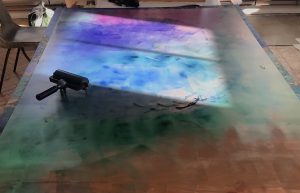
But then the light would begin to creep in, and I’d open the blinds, seeing the work afresh. First thing in the morning I’d dive straight into the work, ready to begin again.
I was curious to discover how my practice might be altered or informed by this particular place. The flora and fauna spoke to me, and led me to consider the possibilities of rewilding our minds into gardens, to paraphrase the William Carlos Williams’s Asphodel, That Greeny Flower (a poem I discovered in a book by Laureana Toledo, lent to me by CAST), ‘the will becomes again a garden. Begin again’.
In the gardens and hedges of Cornwall I also felt close to Etty Hillesum’s epic understanding of flowers at the edge of destruction, when she writes that ‘the purple lupins stand up so regally and peacefully […] and right before our eyes, mass murder. The whole thing is simply beyond comprehension’. Or that ‘somewhere inside me the jasmine continue to blossom undisturbed, just as profusely and delicately as ever it did’. The complexity of my identity, and my ancestral history of forced displacement as well as privilege, came into contact with the landscape in strange ways: how to visit, when to own, where to be, what is mine? I was reading all of these texts at night and they felt more relevant than ever.
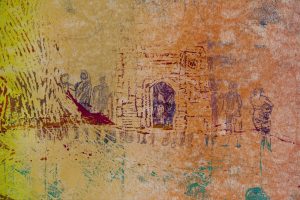
Nan Shepherd’s The Living Mountain spoke to me the most. She writes: ‘By […] altering the position of one’s head, a different kind of world may be made to appear […] as I watch, it arches its back, and each layer of landscape bristles […] Details are no longer part of a grouping in a picture of which I am the focal point, the focal point is everything […] This is how the earth must see itself’. She reminded me of the way the work comes and goes, moving in and out, the coming and going into the studio and out again. The walk through the woods to Lowertown, foliage dripping, a Sunday show in Lamorna, history reclaimed, the hedges lining the roads, hearkening to Macfarlane’s Landmarks and his references to Paul Nash’s unseen landscapes. I was coming and going always, trying to find ways to bring this experience to the studio for anyone who encountered the work.
On one of my last weekend’s, I cycled down to the pop-up sauna at Flushing Beach. From the sauna, I could see across to Falmouth and as the sun gradually set in an array of colours, the lights in the town began to slowly flicker on. Too hot suddenly, I entered the sea, and then hopped back into this warm viewing room from which everything looked picturesque and far. It reminded me of the in and out, the describing of experience and then being of it, the way the residency would live in me, truly, but also be simply a memory I could write about weeks later.
When not in the studio or out in the wilds, I did find time to explore the town of Helston with trips to Pica Rico, charity shops and antique shops, and the Helston Museum which I visited on my final morning. I talked to a lot of strangers, and more than that, they talked to me. Everything operates at a slower pace to London, no one is in a rush and everyone wants to chat. I loved spending ages in a shop, until I found the perfect vintage postcard from the town I was born in (St. Louis, Missouri) or meeting local people at the Blue Anchor who could recommend which pint of Spingo to order.
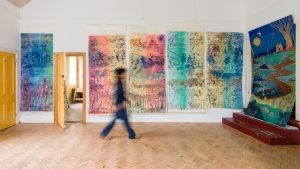
On my last day, I walked up to finally meet the pine tree that had been my sacred guardian. The sun was setting. I looked up into its branches. Close not far, I touched its textured trunk. I felt gratitude for this time. Gratitude for the back and forth, the push and pull, the new meaning of studio, a new land uncovered, exposed, a place recalled and remembered in dreams and visitations.
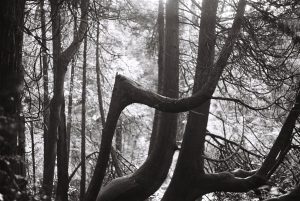
Yael Roberts is based at Cubitt Studios in London.
*Robert Macfarlane’s Landmarks, page 166
